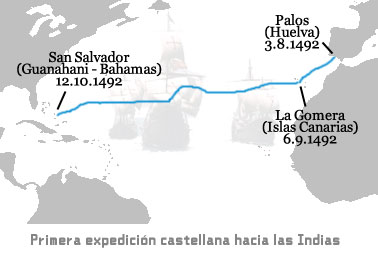Christopher Columbus organized four trips or expeditions to the New World. Three of these trips were exploratory and one colonizer, specifically the second. These voyages of Christopher Columbus, whose objective was to find a route to Asian products in order to trade by sailing west, have been greatly glorified. Instead of finding such a route, he accidentally discovered lands for Western civilization that were not known and that provided the kingdom of Castile with territories of an extension never dreamed of and many riches but also many headaches.
Christopher Columbus never achieved his initial objective: to find the route to Asia and trade in his products. In the capitulations of Santa Fe, the Catholic Kings of Spain agreed with him on the benefits that he would obtain from this trade as well as from the lands he discovered on his way to Asia.
After the signing of these capitulations, he was entrusted with the task of organizing the first trip from the port of Palos de la Frontera in Huelva (Spain). He gathered, not without problems, two caravels and a nao (something bigger) and about 90 crew members. Almost all of them were free sailors and volunteers, there were almost no criminals among them, only the case of one inmate for a tavern fight and three friends who tried to get him out of jail. The intervention of the shipowner and sailor Martín Alonso Pinzón was essential for the success of the organization since most sailors did not believe in Columbus and did not want to accompany him on a trip that they described as suicidal.
The first voyage of Columbus departed from Palos de la Frontera on August 3th ,1492 and in a week they arrived at the island of La Gomera in the Canary Islands where they made some repairs and last supplies. It was not until September 6th that they lifted anchors. They had a quite calm crossing, without great problems or news until on September 25th, Martin Alonso Pinzón seemed to see land but they were nothing more than low clouds. On October 7th, they left the 24th parallel that they had followed and would have taken them to the Florida peninsula and headed southwest toward the Bahamas. That was when Columbus said on October 11th that he saw a little light and when dawn came, it was Rodrigo de Triana who gave the land notice. It was the first documented time that a European had seen American lands, the Discovery of America.
Discovery of the Antilles: Cuba and The Hispaniola Island.
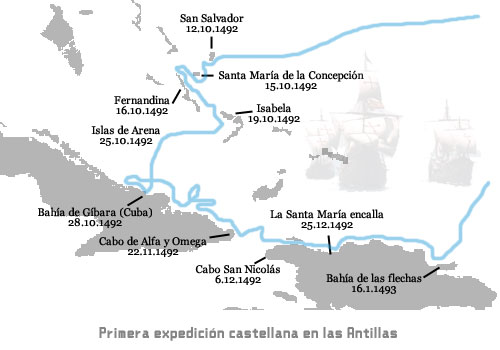
For a little more than a month they sailed around the Antilles that Columbus believed were the islands that existed just before arriving in Asia. When they arrived in Cuba, which Columbus called Juana, on October 28th, he thought that it was already the Asian continent. But seeing that there were no major cities or civilizations but small villages of primitive natives, they must have been puzzled and decided to continue sailing in search of the continent, leaving behind the island of Cuba and arriving at the island of Haiti, which Columbus called the La Hispaniola (now Haiti and Dominican Republic). There they contacted the natives who told them that in the region called Cibao they would find gold and riches. Columbus mistook that name for his resemblance to Cipango (Japan).
Shipwreck of the nao Santa Maria and the Fuerte Navidad
They continued to roam along the north of the island of Hispaniola, and on December 25th the nao Santa Maria landed on a sandbank where she was stranded. Now a serious problem has arisen: the almost 100 crew members could not fit into the two small caravels to return to Castile. Columbus decided to leave 40 men there and they built a small fortress that they called Fuerte Navidad. His mission was to explore the island of Hispaniola and establish friendly relations with the natives, preparing the ground for when they returned on a second trip and continue the colonization of the island. On January 6th the they set off for home arriving in Lisbon after several dangerous storms on March 15,1493. And Martín Alonso Pinzón arrived a few days later in Bayona (Galicia).
The Second Voyage of Columbus
Once in Spain Cristopher Columbus was called by the Catholic Monarchs to explain in Barcelona the details of the expedition and the successes obtained. Columbus appeared before them with several Taino Indians, parrots, a little gold, pearls, indigenous craftsmanship and promises, many promises of many riches and new discoveries. The trick had its effect and the Catholic Monarchs quickly put the legal machinery in place to legitimise these discoveries by signing Pope Alexander VI of the Bull “Inter Caetera II and III” which granted Castile these territories and ordered Columbus to begin the preparations of the second journey already to colonize these territories.
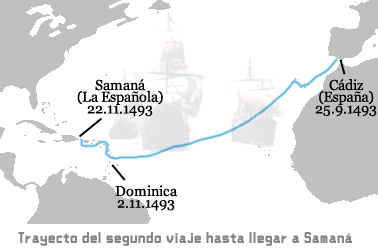
A real colonization fleet of 17 ships and 1,500 people from all professions was quickly set up. Columbus’ lies about that he supposedly found riches and the possibilities of many more took effect and an avalanche of candidates came forward to join the expedition. They departed on September 25th,1493 from the city of Cádiz towards the Canary Islands where they arrived on October 5th. This time the stop was very short and on October 7th they departed from La Gomera and after a quiet and peaceful crossing they arrived on November 2th at the island of Dominica in the Small Antilles. From there they sailed through the rest of the islands passing by the north of the current island of Puerto Rico and on November 22th they reached the peninsula of Samaná on the Hispaniola island. There was a rush to arrive at the Fuerte Navidad in which he had left the 40 Castilian sailors for the shipwreck of the nao Santa Maria, not only to know about them but also to know their advances in exploring the island and their relations with the natives.
Disaster in the Fuerte Navidad
They reached the height of the Fuerte Navidad on November 27th and what a surprise it was when they found out that the same had been destroyed and burned and all its inhabitants murdered. The Caribbean natives had attacked and killed them, leaving none alive. Terror seized the entire expedition. Columbus had said that the natives of the island were peaceful and very docile, and this demonstrated the opposite. The settlers began to distrust Columbus, if he had lied to them about something like that, what other lies would he have told in Castile? This event radically disrupted Columbus’ plans because he was counting on the sailors to have found more wealth, to have established relations with the natives and to have built and built a good base where they could lodge the new expeditionaries. But all of this came to nothing. They had nothing, not even a place to colonize and settle.
Foundation of the first Spanish city in the Indies: La Isabela
They left quickly before the natives could attack them and sailed east to look for a site to found the new colony. A few days later, after exploring and rejecting several places, they found a kind of bay that they found interesting and decided to establish the first Spanish colony in the New World. They named it Isabela and immediately set to work to have the colonial operational as soon as possible with a minimum of comfort. But things began to go wrong soon, an epidemic made many settlers sick and caused many deaths. That wasn’t going to be a rosy road. The city was officially founded on January 6th,1494 with a mass officiated by Brother Bernardo Buyl.
Columbus leaves in search of the Asian continent
Once the colony was more or less established, Columbus left his brother Diego at the head of the Hispaniola island and he left from La Isabela with 96 men and 3 caravels in a northeastern direction to search for the Asian continent and its riches. For a little more than four months they sailed on the south of the island of Cuba, discovered the island of Jamaica, toured the south of the Hispaniola island making a stopover on Saona Island and landed in Puerto Rico for finally and due to a disease of the admiral decided to return to Isabela without having found Asia or even some obvious vestiges of any Eastern civilization.
The Third Voyage of Columbus
Columbus returned to Spain where he met with the Catholic Kinks, this time in Burgos, and was confirmed in all his positions and benefits stipulated in the capitulations of Santa Fe. But this time the kings became more involved in the organization of the third trip to the New World imposing a series of conditions and requirements to lend their support, as was a series of professionals among their expeditionaries and some religious. Columbus had to resort to Genovese banks to finance part of it. On this occasion the bad news that arrived to Castilla from Hispaniola Island about illnesses, hard work, attacks of natives and rebellions made the enthusiasm to enlist go down and it took them more work to complete the crew.
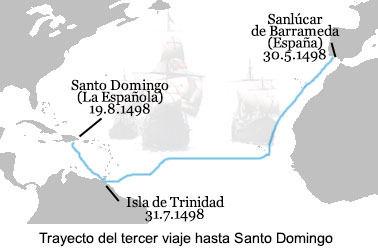 They departed on May 30th,1498 from Sanlúcar de Barrameda (Cádiz) with 6 ships and 226 crew members. As they always sailed to the Canary Islands where the expedition was divided in two, 3 caravels sailed directly to the Spanish island with provisions for their rushed colonists and the other 3, in which Columbus was traveling, continued south to the Cabo Verde islands to travel from there in a straight line crossing the ocean under the line of the Equator because according to a Mallorcan scientist in the areas where the rays of the sun rays fall perpendicular there are many natural riches.
They departed on May 30th,1498 from Sanlúcar de Barrameda (Cádiz) with 6 ships and 226 crew members. As they always sailed to the Canary Islands where the expedition was divided in two, 3 caravels sailed directly to the Spanish island with provisions for their rushed colonists and the other 3, in which Columbus was traveling, continued south to the Cabo Verde islands to travel from there in a straight line crossing the ocean under the line of the Equator because according to a Mallorcan scientist in the areas where the rays of the sun rays fall perpendicular there are many natural riches.
Discovery of South America and rebellions on the Hispaniola island
After a very hard journey with epidemics among the sailors, they reached Trinidad Island on July 31th, discovered the mouth of the Orinoco River and touched for the first time continental land in the northern part of present-day Venezuela. On August 20th they arrived at the newly founded city of Santo Domingo where they found that the island was in a state of rebellion not only of the natives but also of the Spanish settlers who felt swindled by Columbus when they saw that neither gold could be easily taken nor the Indians were docile, wanting to return to Castile much of them or simply being given what they had been promised. There were several riots but the most important was the rebellion of the Mayor of Hispaniola, Francisco Roldán, who managed to raise more than 300 Spaniards and fled to the west side of the island, having in check the power of the Columbus brothers. The admiral finally had to negotiate with the rebels and accept their terms. All these facts had arrived in Castile and the Catholic Kings had no choice but to send a judge to investigate exactly what was happening in the Indies.
In the year 1500 arrived in Santo Domingo the juez Francisco de Bobadilla who took the governorship of the viceroyalty and captured the brothers Colón who were sent to Castilla in a caravel under serious charges.
The Fourth Voyage of Columbus
After the problems that had occurred to Columbus, the Catholic Kings revised the agreements and took away many privileges from the navigator. For example, he no longer had the exclusivity of trips to the New World, other sailors could already be competitors in search of new discoveries. Columbus should continue to look for the step towards Asia and therefore organized this expedition whose objective would be to sail the entire Caribbean coast of Central America trying to cross this unexpected obstacle in the form of a continent and finally reach its longed-for end: India. but would it have happened if he had found a way through the Central American isthmus? He couldn’t know that after this there was another ocean more than twice as wide as the one he had already crossed. With the means of the time and with it something greater would have achieved this objective? We can’t know that.
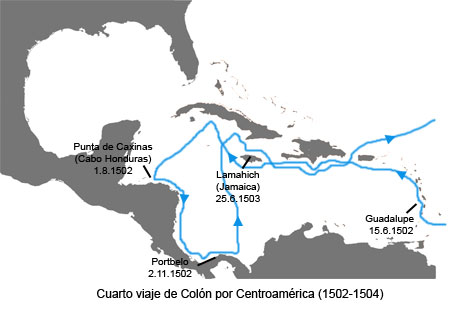 The fourth voyage of Columbus departed from Cadiz on May 9th,1502 to the Canary Islands and on June 15th they arrived in the Small Antilles and from there they went to Santo Domingo where the governor Frey Nicolás de Ovando, by order of the Catholic Kings, prohibited to disembark the admiral to avoid disturbances and had to continue to Jamaica and Cuba, then down to Honduras where on August 1th for the first time occurred a contact between Europeans and Mayans.
The fourth voyage of Columbus departed from Cadiz on May 9th,1502 to the Canary Islands and on June 15th they arrived in the Small Antilles and from there they went to Santo Domingo where the governor Frey Nicolás de Ovando, by order of the Catholic Kings, prohibited to disembark the admiral to avoid disturbances and had to continue to Jamaica and Cuba, then down to Honduras where on August 1th for the first time occurred a contact between Europeans and Mayans.
Discovering Central America
They travelled along the Caribbean coast of Honduras, Nicaragua, Costa Rica and Panama, arriving at the Belen River where they founded the first Spanish city on the American continent: Santa María de Belén. But the enclave did not last more than a few days because of the bad weather, unbearable heat and humidity and the attacks of the natives that cost many sailors their lives. There they lost one of the caravels, destroyed by the prank (little wood-eating mollusk) and damage caused by the storms. They continued to run along the coast until they reached the lands of Veragua that already belonged to the sailor Alonso de Ojeda and therefore had to leave there, not without losing another caravel for the same reasons as the previous one. They only had two caravels left.
There they stayed for a whole year until after several rebellions of the Spaniards who did not agree with Columbus and a small expedition of 2 men to go to Santo Domingo to ask for help by canoe were finally rescued by two caravels and were able to reach the Hispaniola island and save the skin.
The fifth and final voyage of Columbus
Christopher Columbus died in 1506 in Valladolid (Spain) without overcoming the obstacle of the American continent and fulfilling his dream of reaching the Indies. This was not achieved until September 25th,1513, when Vasco Nuñez de Balboa crossed the Panamanian isthmus and discovered the South Sea, which was how the Pacific Ocean was known at that time. But still dead, Columbus had to undergo a fifth and final journey in which his remains were moved for various reasons between several places on both sides of the Atlantic Ocean. He left Valladolid to Seville, from Seville to Santo Domingo, from Santo Domingo to Havana and from Havana to Seville again, where these remains or part of them now rest because in Santo Domingo they claim that the remains they possess are the real ones.
…..
